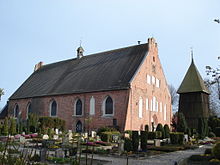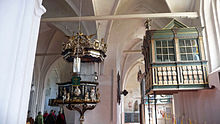Petrikirche (country churches)
The Petrikirche is a medieval church on a small hill in Landkirchen on the island of Fehmarn .
history
In old documents, country churches are referred to as de Landt Kercke . The church of St. Nikolai in Burg is about the same age . The two churches are the oldest on the Baltic Sea island; Until it was built, there was only the Peter and Paul Chapel in the Puttgarden district , which was first mentioned in a document in 1198.
The building of the three-aisled brick church , which was probably built around 1230, has only a small roof turret , the wooden church tower a few meters away was built in 1638 and completely restored in 2016. The originally narrower choir was later enlarged to the width of the nave.
The Petrikirche was not only the ecclesiastical center of the so-called middle parish , but also had a role as a secular center at the intersection of the two roads that cross the island of Fehmarn from north to south and east to west.
Furnishing
In the interior of the church is the Landesblock , a chest cut from a single oak in the 13th century. Until 1867, important documents and seals of the Fehmarn landscape were kept in the state block and secured with iron straps and three locks. The treasurers of the three parishes Wester-, Oster- and Mittelkirchspiel that made up the Fehmarn region each owned one of the three keys. They could only open the state bloc together.
The Petrikirche has a baroque pulpit from 1727, donated by the farmer Drews Wilder. The baptism dates from 1735 (donated by Catharina Mackeprang, a sister of the altar donor). It consists of a goblet-shaped stone baptism with a wooden lid crowned by an angel with a writing tablet and an eight-sided, richly carved barrier, which contains ornamental bandwork at the top and biblical scenes at the bottom. The altar dates from 1715 and is a Jacob Mackeprang foundation. The oldest work of art is a Gothic Mary chandelier from 1390, a double-sided Madonna with baby Jesus in a halo. A library shrine from 1660 with German, English, Danish and Dutch books from the 17th century should also be mentioned, a donation from the provost Conrad Friedrich Stresow from Burg, who bequeathed the collection to the church before his death in 1788.
Two votive ships can be seen in the left aisle : the older of the two, a “Lübscher three-master” built in 1617, is the “oldest replica of a type of ship with verifiable construction and rigging” ( model ship ) and is over a meter long. The model of the three-master Unity is from 1841/1842.
On the side are six boxes from the 18th century, which the rich farmers of the area had built like landlords and which were only accessible from the outside.
Also noteworthy are the wooden prayer stools, which are stored on a special frame at the entrance. There are 66 stools from the 17th and 18th centuries, the size of a footstool, on which you can see inscriptions and decorative marks as well as some of the house brands of local families. House brands are special symbols on Fehmarn that used to be used to mark boundary stones, buildings, pews and the like as the property of certain families. Some house brands, more than 200 of which are known, are reminiscent of Germanic runes or geometric figures.
The so-called Landkirchen reredos was in the church until 1898 . The parish sold the late Gothic work from around 1380 from the area around Bertram von Minden to the Thaulow Museum in Kiel. Since 1950 it has been on display in the State Museum for Art and Cultural History at Gottorf Castle in Schleswig .
Web links
Individual evidence
- ↑ Scharnweber, Werner: Fehmarn . Bremen 2004, p. 94f.
- ↑ Dirk Jonkanski and Lutz Wilde : village churches in Schleswig-Holstein . Wachholtz, Neumünster 2000, p. 85 .
- ↑ Dirk Jonkanski and Lutz Wilde: village churches in Schleswig-Holstein . Wachholtz, Neumünster 2000, p. 119 .
- ↑ Dirk Jonkanski and Lutz Wilde: village churches in Schleswig-Holstein . Wachholtz, Neumünster 2000, p. 37 and 104 .
- ↑ Katz, Michael: Fehmarn . Erlangen 2009, p. 130.
- ↑ Dirk Jonkanski and Lutz Wilde: village churches in Schleswig-Holstein . Wachholtz, Neumünster 2000, p. 118 .
- ↑ Katz, Michael: Fehmarn . Erlangen 2009, p. 34.
Coordinates: 54 ° 27 ′ 3 ″ N , 11 ° 8 ′ 47 ″ E





